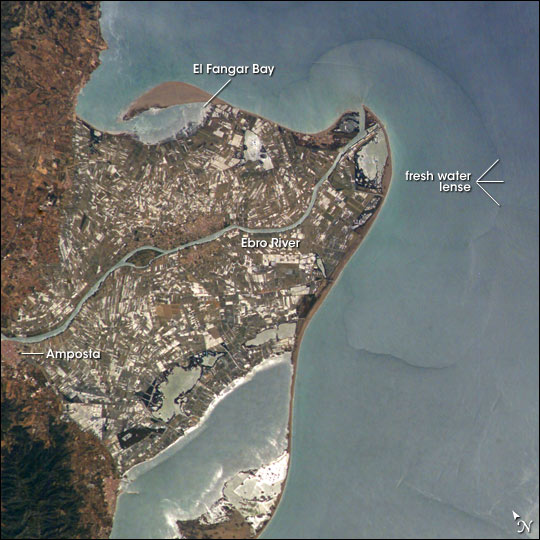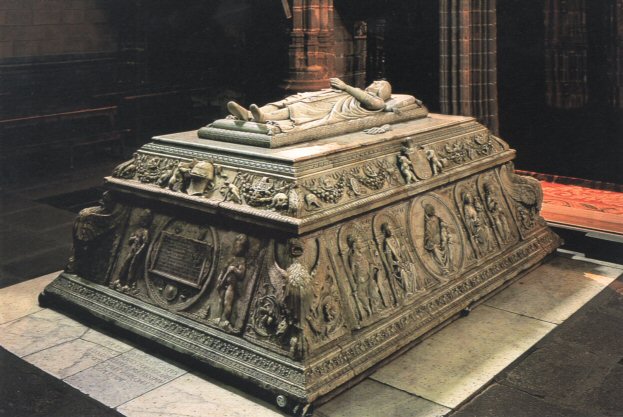|
Reinosa
Reinosa is a municipality in Cantabria, Spain. , it has 10,307 inhabitants. The municipality, one of the smallest by land area in Cantabria, is notable for being one of the nearest towns to the headwaters of the Ebro River. It is surrounded by the municipality of Campoo de Enmedio and was created a city by King Alfonso XIII in 1927, being one of only three urban centres in Cantabria with that honour, the others being Santander and Torrelavega. History The first documents mentioning the town date back to the year 1000, when it was divided into four solars by Sancho García, the Count of Castile. By 1404, it was emerging as the main town of the region and was organised into seven Hermandades, military units aimed at retaining law and order. The procurators of these brotherhoods met once a month with the Corregidor to organise the town's affairs. In 1497, Prince John, son of Queen Isabella I of Castile and King Ferdinand II of Aragon met his affianced wife Margaret of Aus ... [...More Info...] [...Related Items...] OR: [Wikipedia] [Google] [Baidu] |
Campoo De Enmedio
Campoo (formally Campoo-Los Valles) is a ''comarca'' (district) of Cantabria (Spain) located in the High Ebro. With an area of slightly more than 1,000 km2, it includes the municipalities of Hermandad de Campoo de Suso, Campoo de Enmedio, Campoo de Yuso, Valdeolea, Valdeprado del Río, Valderredible, Reinosa, Las Rozas de Valdearroyo, Santiurde de Reinosa, Pesquera, and San Miguel de Aguayo. The local inhabitants are called ''Campurrians'' (Campurrianos, in Spanish). Its highest elevation is the Cuchillón peak (2,225 m above sea level), and the lowest is Pesquera (560 m), with the capital, Reinosa at 850 m. According to the ''Book of Merindades of Castile'' (from circa 1352), the ''merindad'' (subdivision) of Aguilar de Campoo comprised municipalities in the south of present-day Cantabria, as well as of northern Palencia and Burgos, with its capital at the Palentine Aguilar de Campoo (also the former capital of the vast marquisate of Aguilar de Campoo). Later the ca ... [...More Info...] [...Related Items...] OR: [Wikipedia] [Google] [Baidu] |
Cantabria
Cantabria (, ; ) is an autonomous community and Provinces of Spain, province in northern Spain with Santander, Cantabria, Santander as its capital city. It is called a , a Nationalities and regions of Spain, historic community, in its current Statute of Autonomy. It is bordered on the east by the Basque Country (autonomous community), Basque autonomous community (Biscay, province of Biscay), on the south by Castile and León (Province of León, provinces of León, Palencia (province), Palencia and Province of Burgos, Burgos), on the west by the Asturias, Principality of Asturias, and on the north by the Cantabrian Sea, which forms part of the Bay of Biscay. Cantabria belongs to ''Green Spain'', the name given to the strip of land between the Bay of Biscay and the Cantabrian Mountains, so called because of its particularly lush vegetation, due to the wet and temperate oceanic climate. The climate is strongly influenced by Atlantic Ocean winds trapped by the mountains; the averag ... [...More Info...] [...Related Items...] OR: [Wikipedia] [Google] [Baidu] |
Ebro
The Ebro (Spanish and Basque ; , , ) is a river of the north and northeast of the Iberian Peninsula, in Spain. It rises in Cantabria and flows , almost entirely in an east-southeast direction. It flows into the Mediterranean Sea, forming a delta in the Terres de l'Ebre region, in southern Catalonia. In the Iberian peninsula, it ranks second in length after the Tagus and second in discharge volume, and drainage basin, after the Douro. It is the longest river entirely within Spain; the other two mentioned flow into Portugal. The Ebro flows through many cities (): Reinosa in Cantabria; Frías and Miranda de Ebro in Castile and León; Haro, Logroño, Calahorra, and Alfaro in La Rioja; Tudela in Navarre; Alagón, Utebo, and Zaragoza in Aragon; and Flix, Móra d'Ebre, Benifallet, Tivenys, Xerta, Aldover, Tortosa, and Amposta in the province of Tarragona (Catalonia). Geography Upper part and tributaries The source of the river Ebro is in the Cantabrian Moun ... [...More Info...] [...Related Items...] OR: [Wikipedia] [Google] [Baidu] |
Corregidor (position)
A ''corregidor'' () was a local administrative and judicial official in the Spanish Empire. They were the representatives of the king, royal jurisdiction over a town and its district. The name comes from the word ''corregir,'' meaning "to correct". He was the highest authority of a ''corregimiento''. In the Spanish Americas and the Spanish Philippines, a ''corregidor'' was often called an ''alcalde mayor''. They began to be appointed in Pre-Spanish Imperial fourteenth century Kingdom of Castile, Castile. Development in Spain The idea of appointing Spanish Crown, Crown officials to oversee local affairs was inspired by the Roman law#In the West, late-medieval revival of Roman law. The goal was to create an administrative bureaucracy, which was uniformly trained in the Roman model. In spite of the opposition of Cabildo (council), council towns and the ''Cortes Generales#History of the Cortes, Cortes'' (Parliament), Castilian kings began to appoint direct representatives in towns ... [...More Info...] [...Related Items...] OR: [Wikipedia] [Google] [Baidu] |
Solar (Spanish Term)
In Spanish urban development a ''solar'' is a plot of land that meets minimum conditions to be built on , RAE. Retrieved on July 11, 2012. and developed properly according to existing land use regulations. These conditions relate primarily to and access to the , disposal or purification of and [...More Info...] [...Related Items...] OR: [Wikipedia] [Google] [Baidu] |
Sancho García Of Castile
The name Sancho () is an Iberian name of Basque origin (Santxo, Santzo, Santso, Antzo, Sans). Sancho stems from the Latin name Sanctius. Feminine forms of the name are Sancha, Sancia, and Sanchia (), and the common patronymic is Sánchez and Sanches. Outside the Spanish-speaking world, the name is especially associated with the literary character Sancho Panza. Sancho is a common slang term in the Spanish speaking world for the other man in the relationship. As in a spouse or girlfriend who is being unfaithful with a Sancho. Sancha is the feminine equivalent. Kings of Navarre * Sancho I * Sancho II * Sancho III * Sancho IV * Sancho V (also king of Aragon) * Sancho VI * Sancho VII Kings of León and Castile * Sancho I (León) * Sancho II (León and Castille) * Sancho III (Castille) * Sancho IV (León and Castille) Kings of Portugal * Sancho I, ''o Povoador'' * Sancho II, ''o Capelo'' King of Majorca * Sancho Dukes of Gascony * Sancho I * Sancho II * Sancho III * Sanch ... [...More Info...] [...Related Items...] OR: [Wikipedia] [Google] [Baidu] |
Santa Hermandad
Santa Hermandad (, "holy brotherhood") was a type of military peacekeeping association of armed individuals, which became characteristic of municipal life in medieval Spain, especially in Castile. Modern hermandades in Spain, some of which evolved from medieval origins, are now for the most part religious confraternities retaining only a military structure and ethos. Background As medieval Iberian kings of León, Castile, and Aragon were often unable to maintain public peace, protective municipal leagues began to emerge in the twelfth century against bandits and other rural criminals, as well as against the lawless nobility or mobilized to support a claimant to the crown. These organizations were individually temporary, but became a long-standing fixture of Spain. The first recorded case of the formation of an ''hermandad'' occurred when the towns and the peasantry of the north united to police the pilgrim road to Santiago de Compostela in Galicia, and to protect the pilg ... [...More Info...] [...Related Items...] OR: [Wikipedia] [Google] [Baidu] |
Isabella I Of Castile
Isabella I (; 22 April 1451 – 26 November 1504), also called Isabella the Catholic (Spanish: ''Isabel la Católica''), was Queen of Castile and List of Leonese monarchs, León from 1474 until her death in 1504. She was also Queen of Aragon from 1479 until her death as the wife of King Ferdinand II of Aragon, Ferdinand II. Reigning together over a Dynastic union, dynastically unified Spain, Isabella and Ferdinand are known as the Catholic Monarchs of Spain, Catholic Monarchs. Her reign marked the end of Reconquista and also the start of Spanish Empire and dominance of Spain over European Politics for the next century. After a struggle to claim the throne, Isabella reorganized the governmental system, brought the crime rate down, and unburdened the kingdom of the debt which her half-brother King Henry IV of Castile, Henry IV had left behind. Isabella's marriage to Ferdinand of Aragon in 1469 created the basis of the ''de facto'' unification of Spain. Her reforms and those she ... [...More Info...] [...Related Items...] OR: [Wikipedia] [Google] [Baidu] |
John, Prince Of Asturias
John, Prince of Asturias and Girona (; 30 June 1478 – 4 October 1497) was the only son of King Ferdinand II of Aragon and Queen Isabella I of Castile, and heir apparent to both their thrones for nearly his entire life. Early life The only son of the Catholic Monarchs, John was born in Seville on 30 June 1478. At the time, his parents were involved in the War of Castilian Succession against Isabella's niece Juana la Beltraneja, wife of King Afonso V of Portugal.John's birth helped consolidate Isabella's position as a sovereign. At the time of his birth, he had one elder sister Isabella; his younger sisters were Joanna, Maria, and Catherine. The Catholic monarchs won the war against the King and Queen of Portugal. To negotiate a peace settlement with Isabella, King Afonso sent Infanta Beatrice, Duchess of Viseu. The two women met in March 1479. Beatrice was Afonso's sister-in-law and Isabella's maternal aunt. By terms of the treaty they eventually negotiated, the former Q ... [...More Info...] [...Related Items...] OR: [Wikipedia] [Google] [Baidu] |
Santander, Spain
Santander ( , ; ) is the capital of the Autonomous communities of Spain, autonomous community of Cantabria, Spain. It has a population of 172,000 (2017). It is a port city located in the northern coast of the Iberian Peninsula, facing the Cantabrian Sea. It is believed to have been a port since ancient times, due to its favourable location, and is documented as far back as the 11th century. Much of the old city was lost in the 1941 Santander fire, Great Fire of 1941. The city was then rebuilt realizing Francoist ideals of social segregation. Today, its remaining old town, beach and other attractions are popular with tourists and other visitors and its economy is mainly service based. The port is still very active and a regular ferry service operates to the United Kingdom. Fish and seafood dominate the local cuisine. Santander notably houses the headquarters of multinational bank Banco Santander, which was founded there. The city has a Santander, Spain#Climate, mild climate typic ... [...More Info...] [...Related Items...] OR: [Wikipedia] [Google] [Baidu] |
Ferdinand II Of Aragon
Ferdinand II, also known as Ferdinand I, Ferdinand III, and Ferdinand V (10 March 1452 – 23 January 1516), called Ferdinand the Catholic, was King of Aragon from 1479 until his death in 1516. As the husband and co-ruler of Queen Isabella I of Castile, he was also King of Castile from 1475 to 1504 (as Ferdinand V). He reigned jointly with Isabella over a Dynastic union, dynastically unified Spain; together they are known as the Catholic Monarchs. Ferdinand is considered the ''de facto'' first king of Spain, and was described as such during his reign, even though, legally, Crown of Castile, Castile and Crown of Aragon, Aragon remained two separate kingdoms until they were formally united by the Nueva Planta decrees issued between 1707 and 1716. The Crown of Aragon that Ferdinand inherited in 1479 included the kingdoms of Kingdom of Aragon, Aragon, Kingdom of Valencia, Valencia, Kingdom of Majorca, Majorca, Kingdom of Sardinia, Sardinia, and Kingdom of Sicily, Sicily, as well as ... [...More Info...] [...Related Items...] OR: [Wikipedia] [Google] [Baidu] |






